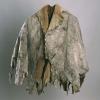Quilt No.765PHM - Powerhouse Museum

"The maker's name is not documented, but was probably Mr Albury Treanor and/or his wife. The skins came from possums shot in the early 1930s by Albury Treanor, who lived at 34 Underwood Street, Forbes; they were tanned by Pulbrook of Bathurst. The rug was hand stitched and used by the Treanor family on their bed.
"The rug was a gift from Mr. Pat Williams to the Powerhouse Museum in 1987. Pat Williams was probably the husband of Fanny Bruce Williams, nee Treanor, from whose collection the rug came." [PHM]
"Information from Kay Williams, Pat Williams' daughter:
The family owned four skin rugs on their beds including fox, kangaroo and rabbit. The skins for these were mainly shot at Grudgery Mountain, 30 miles west of Forbes. Twenty men would go out in an old truck at about four in the morning and shoot until ten am. Much of the family's life revolved around shooring and fishing." [PHM]






